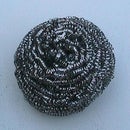Introduction: DIY LED BULB: $20 for $10
S T O P____S L A U G H T E R____I N____U K R A I N E !
* * *
Yes, if you know whether resistor differs from transistor and can manage soldering iron, you can save a lot of money.
Let's calculate DIY E27 LED replacement lighting bulb:
1. LED bead x 16 pcs = $ 0,15 x 16 = $ 2,4
2. Heatsink < $1,5 if new, or almost for free if used
3. Brushless fan ~ $ 1 if new, or almost for free if used
4. LED driver x 2 pcs = $ 4 or less if bulk price applied
5. Fan' power supply you can made for $ 2 or less
6. Rest of electronic parts < $ 2
7. Bulb casing is just waste products cost almost nothing
8. Several drops of Super Glue
9. Spare time
10. Inspiration
Well, we got $ 10 .. $ 12 in total per item in the WORST case (all parts are new and purchased for money). Plus you get almost thoroughly repairable and tunable design unlike majority of ready made LED-replacements. Pretty beneficial alignment I suppose...
***
Power LED' heatsink' operating temperature shouldn't exceed 50 C. Modern brushless coolers in the package with staff heatsinks can help designer to meet this requirement easily, unlike passive (convective) cooling systems which sizes, weights and complicated embedding seem to be just out of style nowadays.
Active cooling system' shortcomings are: airflow noise, vibrations, extra power consumption, extra money, lower reliability in comparison with pure convective (passive) cooling systems. Let's make out all these points one by one.
1. Airflow noise. The possible and obvious solution here is to power our cooler not with nominal 12 V DC but with lower voltage, from 5 V DC up to 10 V DC. As a result airflow's noise decreases dramatically, as well as mechanical vibrations coupled with mechanical audible overtones. Decreased cooling ability of the system may be compensated by heatsink' sizing and / or appropriate decreasing of total LED' power dissipation. In other words, there is quite enough space to maneuvre.
2. Extra power consumption. The lower feeding voltage - the lower fan's power consumption. Typical value is up to 1W per 15W LED replacement bulb. Absolutely insufficient value as I suppose.
3. Extra money. Disputable point as well so as large and heavy equivalent convectional heatsink costs money too.
4. Lower reliability. On the one hand, brushless fans' robustness and durability are thoroughly proved by last 20 .. 30 years; on the other hand, certain pretty simple but effective automation may be provided to eliminate fan' failure' possible consequences.
Well, as I suspect, the disadvantages are quite cleared. Let's proceed to practice.
Step 1: 1W LED X 16 Pcs Meet Their Heatsink
Each aluminum sleeve (lathe is desirable) is lower than LED white plastic shell height ~ 3 mm + mica plate thickness 0,2 mm (sum height of them) for 0,1 mm that gives proper mounting LED shell tension towards the heatsink. Each LED bead has two tension points that give pretty low Rth case to heatsink and reliable insulation as well.
Step 2: Off-the-shelf LED Driver
- short circuit protection
- open circuit protection
Step 3: Custom Made 5 .. 12 V DC Fan's Power Supply + Overheat Protection System
PI - forever. I don't know another company so deliberately cares about simple DIYers around the world, just like me and many of you reading this ible. Their PIExpert suite 9.0 is just outstanding and most useful software for me I've ever known. Well, IR is really cool and high, but PI - you guys are just the best! )) That was dithyramb from the bottom of my heart.
http://ac-dc.power.com/design-support/pi-expert-su...
http://pdf1.alldatasheet.com/datasheet-pdf/view/52...
Temperature sensor (NTC type 0603 SMD size) is secured on the 0,2 mm thickness mica plate with the drop of super glue. The reliable insulation here is the VITAL POINT for the fan' power supply circuit is not galvanically insulated from AC line high voltage.
Attachments
Step 4: Sewage Pipe Dismountable Casing, E27 Socket, and AC Line Input Protective Stage
50 mm PVC sewage pipe turned out to be cheap and widespread material to make variety of DIY things, LED bulb's case in particular. And the ordinary Super Glue is one of the best glues for such a sort of plastic.
Lighting unit's inner ring is formed by the same piece of sewage pipe. Little bulges along the ring's cylindrical surface are the hardened superglue' s drops; they help to secure the inserted lighting unit's plug into bulb's shell tightly. Perforated plastic washer is made out from domestic PVC rectangular ventilation duct with the help of metal shears and drill. E27 socket is borrowed from burned out incandescent bulb.
Cooler's power supply and a pair of LED drivers are bundled together with a several turns of thick thread, and placed into bulb's shell - a piece of sewage pipe of 25 .. 30 mm in height. A piece of insulator laid between them in order to prevent shortings. Electronic units aren't secured in the shell especially, for bundle's outline dimensions fit the inner cavity's cross section of the bulb's shell tightly.
Most of flat surfaces inside the shell are oriented by the fan's incoming airflow, so heat dissipative electronic parts find themselves into pretty good thermal conditions that increase reliability and durability of the device as a whole.
AC-line protective stage consists of 27R 0,5W resistor that reduces destructive sparks prodused by switch-ons inrush current spikes; 0,5A fuse, and 275V 14mm varistor that cuts away any narrow high voltage spikes, especially when powerful brush motors run beside our device.
Step 5: Assembling and Final Test
Questions, clarifications, tips, hints and comments are welcome! ))
S T O P____S L A U G H T E R____I N____U K R A I N E !













